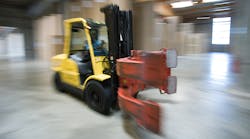National Forklift Safety Day: Giving Forklift Safety a Platform
While the job of a forklift operator is not an easy one, with many concerns to keep abreast of, safety should be at the top of the list. Training is a vital element in making this happen. And it has been proven that the proper training of forklift operators is key to effective forklift safety.
National Forklift Safety Day
Toyota Industrial Equipment, Trelleborg Wheel Systems and Raymond are key sponsors of National Forklift Safety Day, which was founded by the Industrial Truck Association. On June 8 and 9, forklift industry companies and their representatives, OSHA and a representative from the Department of Labor will come together at the Hyatt Regency Capitol Hill Hotel in Washington D.C. to discuss issues of forklift safety.
This two-day event provides a platform for the lift truck industry to present to legislators and create better awareness of safe forklift practices.
Representatives are able to come together to educate on safety, regulatory, and economic issues. Additionally, it reinforces the importance of safety during the operation and maintaining of forklifts, by emphasizing OSHA-sponsored training programs, operator certifications and devising and implementing a safety checklist.
Best Practices for Forklift Safety
The proper maintaining of forklifts will be addressed as part of National Forklift Safety Day. Leaders in the forklift industry are becoming more pro-active with OSHA and implementing their guidance.
Checklists for forklift operators play a vital role in daily forklift use and unfortunately can be easily overlooked. It is helpful to make it a habit with forklift operators just as they would in strapping their seatbelt in their car. Safety can be greatly impacted and equipment compromised when operators cannot be bothered with taking the time to check over even the most basic of forklift components and functionality. It can be as simple as the operator checking tires, the battery, blinkers, horn, steering, braking and travel controls.
From a maintenance perspective, it is helpful to break the checklist down into categories:
Under the hood: operators should be sure to check the motor oil, brakes, hoses, power steering, coolant level, batteries, fuel line leaks belt tensions, and fuel level.
Interior category: check the steering, mirrors, clutch, horn/safety devices, meters and gauges/controls.
Exterior category: forklift operators should check tires, wheels, lug bolts, hydraulic reservoirs, hydraulic lines, stoplights, head- and tail-lights, directional signals, warning lights, steering mechanism, drive line, universal joints, ROPS (rollover protection system), forks, propane tank, and coupling devices
General category: check the exhaust system, engine, fire extinguisher, slow moving triangle and first aid kit.
Preventing Forklift Accidents
Tipping of the forklift vehicle accounts for approximately 42 percent of forklift fatalities due to the operator being crushed. Many injuries have ensued from not using the seatbelt. According to OSHA, operators of powered industrial trucks are obligated to use a restraint or seatbelt. OSHA also has the ability to fine a company, which can cost up to $7,000 for ‘minor’ infractions and up to $70,000 for repeat offenders.
According to the National Safety Council, the average direct cost to a company for a forklift incident is $38,000 with $150,000 in indirect costs. Thus far, innovations such as this are catching the attention of politicians - especially in the wake of injuries caused by forklift accidents. OSHA statistics from 2013 report that there are approximately 85 forklift fatalities and 34,900 serious injuries yearly.
